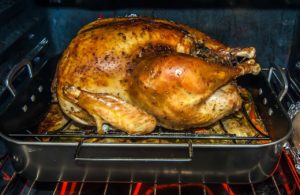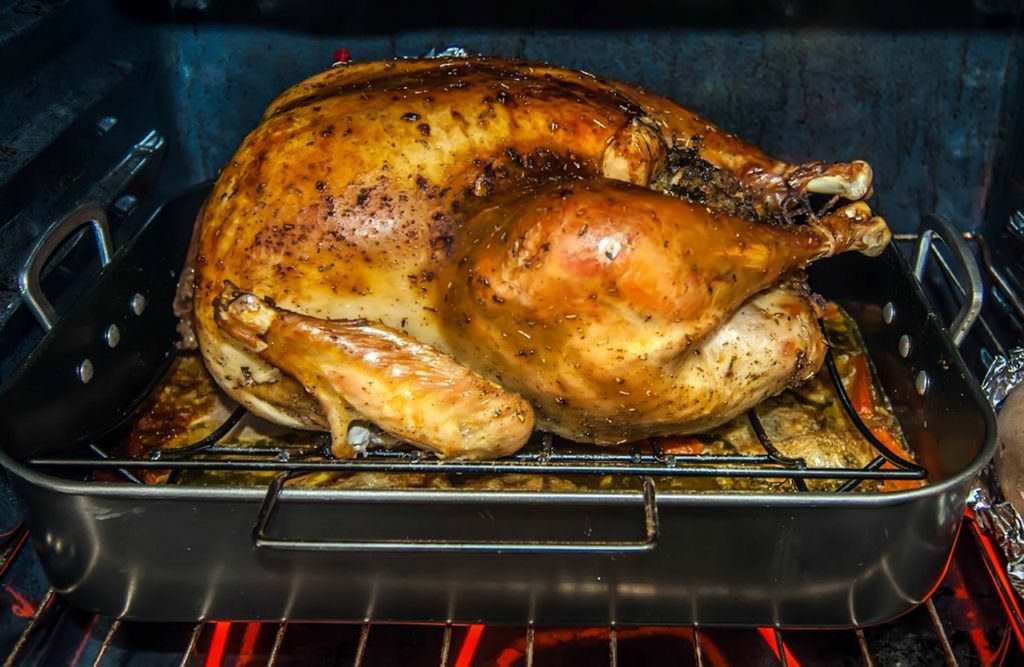Thanksgiving safety is not something that generally comes to mind when you think of the holiday. But one fire chief explains that Thanksgiving is the day when most structure fires occur. While you should always have working smoke detectors, take the extra step to make sure they’re working just in case you drip a little too much grease or forget about those biscuits in the oven while you’re busy visiting with family.
When you’re cooking your Thanksgiving turkey, make sure you know the proper ways to thaw, prep, and cook your turkey so your holiday doesn’t go up in smoke.
1. Thawing
The USDA FSIS (United States Department of Agriculture Food Safety and Inspection Service) recommends two ways to properly thaw a frozen turkey: in the fridge or in cold water.

For every 4-5 pounds of frozen turkey, you’ll need to thaw the turkey for approximately 24 hours in the fridge. An approximate table of thawing times is listed below. After thawing, an uncooked turkey can remain in the fridge for up to 2 full days.
| 8 to 10 pounds | 2 full days |
| 12 to 15 pounds | 3 full days |
| 16 to 20 pounds | 4-5 days |
| 20 to 25 pounds | 5-6 days |
Another way to defrost a frozen turkey is in cold water that’s changed every 30 minutes. Allow approximately 30 minutes for every pound of frozen turkey. Experts recommend placing the turkey in a leak-proof bag to prevent the turkey from leaking and causing contamination and to prevent the turkey from absorbing water.
2. Preparation
Many people get sick every year from improper turkey handling making safe preparation of a turkey a key part of the cooking process. Uncooked and undercooked turkey can have bacteria that can make your guests sick. According to the Centers for Disease Control and Prevention (CDC), the most frequent outbreaks of food poisoning are in November and December and “meat and poultry accounted for 92% of the outbreaks with an identified single food source.”
Anywhere that raw turkey touches should be washed before other food comes into contact with it. This includes your hands, cutting boards, sinks, and counters. This will help prevent bacteria from being transferred to other foods.
Stuffing the Turkey
It’s a risk to stuff a turkey, as undercooked stuffing can harbor bacteria and cause foodborne illness. To avoid this, you can cook stuffing outside and separate from the turkey. However, if you do choose to stuff your turkey, make sure the center of the stuffing registers at least 165 degrees.
3. Cooking
Baking
If you bake your turkey, set your oven to no lower than 325 degrees. The Minnesota Department of Health (MDH) gives the following approximate baking times based on weight.
| 8 to 12 pounds | 2¾ to 3 hours |
| 12 to 14 pounds | 3 to 3¾ hours |
| 14 to 18 pounds | 3¾ to 4¼ hours |
| 18 to 20 pounds | 4¼ to 4½ hours |
| 20 to 24 pounds | 4½ to 5 hours |
To roast a turkey, make sure the temperature inside the turkey registers at least 165 degrees at the meaty portion of the breast and thigh. For the best results, let the bird stand for at least 20 minutes after you pull it out of the oven.
Deep Frying
Deep frying is a popular but dangerous method for cooking a turkey. If you choose to deep fry a turkey, select a fully thawed 10-15 lb. bird and set up the fryer outside, on a level surface.
To determine the amount of oil you’ll need, lower the uncooked bird into the unfilled fryer. Fill the fryer with cold water a few inches above the turkey, measuring the water you add, as this is how much oil you will need. Make sure there are several inches between the surface of the water and the top of the fryer. Many fires are caused by fryers being overfilled with hot oil that splashes onto the burner and ignites after the turkey is placed in the fryer.
While people generally enjoy the taste of deep fried turkey, if you’re considering deep frying a turkey, some complaints include a lack of pan drippings to make a gravy and the inability to boil the carcass for soup.
If all of this seems a little too complicated, you can always try to enlist someone else to cook the turkey this Thanksgiving! Or, try an alternative to traditional turkey such as tofurkey (a vegetarian turkey replacement made in part from tofu) or skip the turkey altogether and make a new tradition of ordering pizza! Whatever you choose, we wish you happy eating and a safe and enjoyable holiday.
Updated May 19, 2020
Sources: AllRecipes, MLive, CDC, USDA FSIS, MDH

